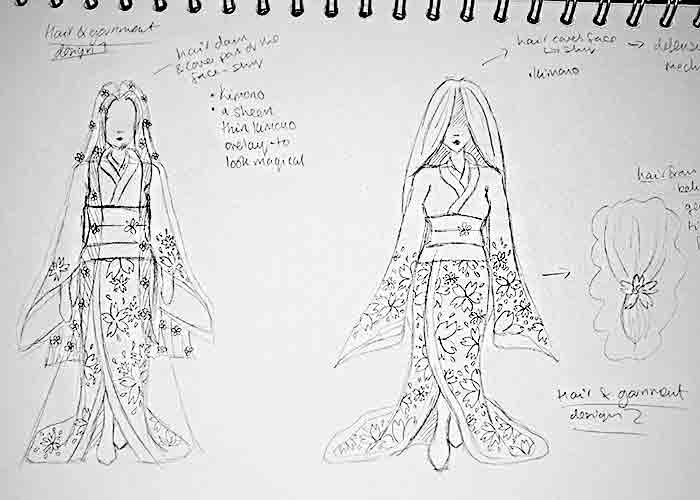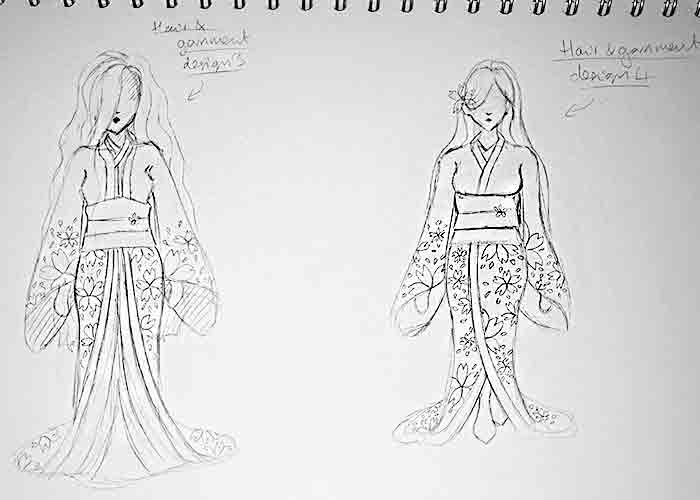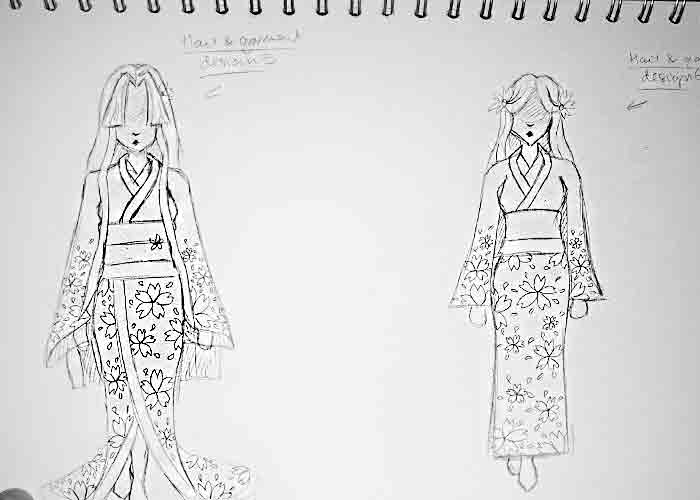


Now that I had created the basic patterns for Sakura's kimonos, I could then start to think about the different styling of the kimonos, and her overall look.
A popular female kimono style was to have long sleeves called a furisode. This kimono is most commonly worn by young women, and is believed to ward off evil and bring in good luck and relationships. I wanted to dress Sakura in this style of kimono as she had no luck being in tree form, and she had no relationships with nature either. All nature avoided her as they believed her to be strange and evil.
One of her recognisable features will be her sakura obijime. This will always be part of her character design and idenity. Obijime is used as decoration and not used to hold the obi in place. This obijime will always be pink.
I thought about playing around with the idea of layered kimono to create a gathered look. But, layered kimono is more commonly worn by royalty or aristocrats, this did not fit Sakura's persona, I decided to come away from this idea and to keep it simple.
For a couple of the designs, I started to play around with the idea of the hair covering the face. Majority of them turned out to look quite ominous instead of shy/unconfident, which was not what I was aiming for. I decided I would focus on the hair later, seperately.
Sakura's character is shy, gentle and does not understand her own self worth. I thought about incorporating this into her look, primarily using her hair.
The styling of her hair throughout the story will help the viewer gauge Sakura's state of emotions. When her hair is sweeped over her face (like in slide 3) she will be feeling down, sad, shy or hopeless.
As the story develops, you start to see her confidence change along with her hairstyle. The happier she is, the less she hides behind her hair, resulting in hair that no longer covers part of her face.
One of my original hair designs was a japanese traditional hair style (as seen on slide 1). This style of hair is very clean, precise and quite a harsh hairstyle. My personal opinion was that this style of hair suits a much darker hair colour. A gentle character, such as Sakura, who has a light and soft hair colour suits a more soft and bouncy hairstyle. So, this is why I started to lean towards hairstyles that gently frame the face using circular shapes.
At this stage, I started to experiment with incorperating flowers into the hair. Kanzashi (japanese hair ornamnets) have been a part of japanese culture from the Jomon period. They are used to elevate a hairstyle as well as show stature. The flower ornamnet will only be used to elevate her hairstyle in this story.
The final Sakura character designs features 3 different outfits (transformation, Adachi and occasional outfits) and 4 different hairstyles. The Adachi look will be allowed to mix and match hairstyles.
The transformation look ‐ This look features a kanzashi pin that is disguised as a sakura flower. This pin will feature in all 3 looks and will sit just above the ear. Her hair will gently frame her face and body, one of her eyes will be covered by hair, held in place by the kanzashi.
All kimono will be in the furisode style, but this kimono pattern will consist of small sakura flowers that wrap around the body and finish below the obi. Her signiture obijime will sit on the obi and feature in all 3 designs.
The Adachi look ‐ This look is a more tradititonal japanese look with the style of hair being up and kimono patttern. I styled this look from the primary research based off my experience dressing in traditional japanese clothing.
Unlike with the first outfit, this one will be accompanied by geta (traditional wooden sandals). This is because at this point in the story she has integrated into japanese society, and it would be obscene to walk around with no footwear.
Occasion and festival look ‐ I wanted this design to look and feel really special as well as extravagant. This being because when you go out for a special occasion you dress up nicer, and make more of an effort with your apperance. I wanted to apply the same princple to this look.
Her half updo is fashioned from a popular edo period hairstyle, fashioned by young woman in the 1850's, I took a modern twist on the look and swapped out the tight pulled back hair for hair that gentley framed the face.
The kimono pattern is more plentiful and the colour combination will have the biggest contrast from all 3 kimonos. This kimono will be the only kimono that is not a shade of pink, but blue.